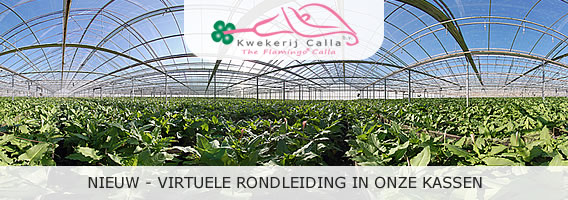Cutting:
It is best to cut with a sharp knife, the Calla a bit off, preferably in the white part.
Brown border:
A brown edge at the end can sometimes mean that the flowers were already old. It is also possible that the air in the living room is very dry, so the edges dry out and turn brown.Mucus:
It is best to set the Calla on the preservative. The the build-up of slime is in fact often caused by a bacterium. With disinfectant bacterial growth is inhibited and thus reduces the risk of mucus. It is advised to place the flowers on a chlorine pill or bulb flowers food on little water to prevent mucus. Saturated stems will show mucus much faster. Before placing the flowers in a vase drain them thoroughly and cut them off well. Cut off the stem regularly, change the water and immediately remove mucus stems, because mucus is quite contagious.
Colors:
Each year more and more beautiful colors are added and the shelf life is getting better. The most common colors are: red, orange, yellow, green, pink, purple, white, black, two-tone.
Small callas:
Small Callas are young flowers; this is very dependent on the species. However, within species there can also be different flower sizes dependent on plant development, cultivation methods and season.
Shelf life:
In principle, all Calla flowers have a pretty good shelf life. Fresh flowers can be 7-14 days in the vase. The supplied flower food must be added in the correct dose, it contains a preservative that gives your Calla a longer shelf life. This flower food keeps the water free of bacteria, and prevents the Calla from mucus stems.
Naming:
Why are there so many different names? Zantedeschia was originally called Arum Aethiopicum or Ethiopian Arum. At that time (18th century) Africa was largely unknown in the western world and Ethiopia served as a representative for almost all of Africa. Other names for the plant are: Calla Aethiopica, where ‘Calla’ in Greek means ‘beautiful’, ‘Richardia Africana’, after the French botanist Richard. Eventually they kept it on Zantedeschia, after the Italian physician and botanist G. Zantedeschi (1773-1846). Aethiopica is Greek for ‘growing in Moreland’ or ‘scorched by the sun’. Nowadays Zantedeschia is known as Calla or Arum.
Flexibility:
For making bouquets and flower arrangements the Calla is very elegant. The green stem of the Calla is very flexible and helps to make beautiful creations.
Purchasing Tips:
When purchasing Callas it is important that the flower is free from pests and diseases. The Callas should be closely monitored for freshness by assessing the maturity of the ear and the freshness of the bract. It is also important to pay attention to so-called mucus stems which can greatly affect the non-perishability. Damaged or dirty flowers are often caused by transportation or storage. Growers sometimes treat the Callas with a chlorine pill, to go. Against bacterium.
Please note when shopping: stem length (30-100 cm), maturity, flower size, shape and color of the bract, stem bending coefficient and quality.
Aging:
Protect the flowers from draft, direct sunlight or another heat source. Do not place the flower close to the fruit bowl. Fruit gives off ethylene gas from nature. This hormone causes flowers to age faster.
Mold:
Watch carefully: the flowers can not be too high on humidity (RH) or condensation in the cellophane. This will stimulate botrytis, a fungal disease that diminishes the ornamental value quickly. Beware of damage or impact of the bracts, so always pick the flowers by the stem. Every bump or touch later on can result in black discoloration
Tricks:
The two tricks to keep your flowers last longer are: the right temperature and ultra clean water. Bacteria in the water spoil your flowers a lot sooner. Follow these tips and you can enjoy much more of your flowers. Let the Callas without water for a few hours so that the stem softens, fill a goldfish bowl half with water and curl the Callas carefully into the bowl, starting with the flower. Because the flowers the flowers do not come out above the bowl it seems like they are floating.
Moisture Drops:
The phenomenon of moisture droplets on the leaf is also called guttation. Most plants evaporate their water through the leafs. When the plant absorbs more water than it can evaporate, the plant presses the water out of the leaf as a water drop. To avoid this phenomenon limit the water supply.
Light:
A Calla needs plenty of light. Indoors place the plant during low light periods in full sun. During periods of rich light, place the plant in the shade. Outdoors do not place the plant in full sun. Most suitable is to place the Calla a large part of the day in the shade. Because a Calla has many buds, many new flowers can bloom. To encourage this growth sufficient light is needed. If there are no new flowers blooming within a few weeks, they will no longer appear. The plant than puts all its energy in the tuber
Temperature:
At a temperature between 12˚ and 20˚ C the Calla remains beautiful for a long time. If the minimum temperature drops below 5˚ C damage to the plant is created. At high temperatures, the Calla age faster.
Overblown:
After the flowering period, the Calla loses color. Besides the loss of color the flower closes and wilts. In spite of regular watering and the right spot, this cannot be countered. Break the old flowers from the plant. If the Calla has finished the leaves die slowly so that the energy can be again stored in the tuber. As a result, the leaves turn brown. This process takes place about 8 weeks after flowering. If brown leaves arise earlier, they can be broken off.
 English
English  Nederlands
Nederlands 
